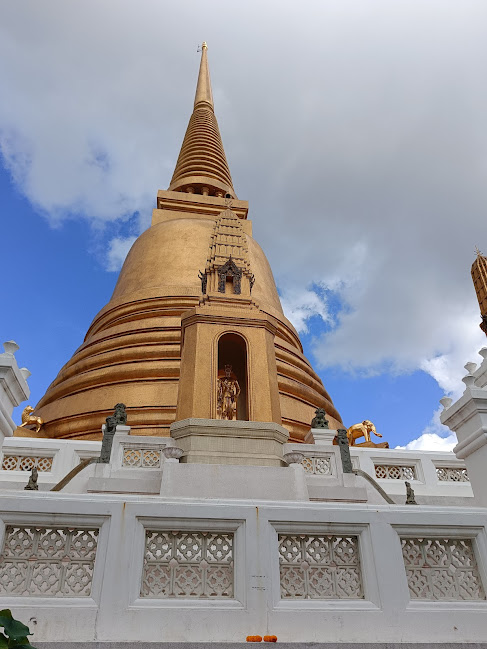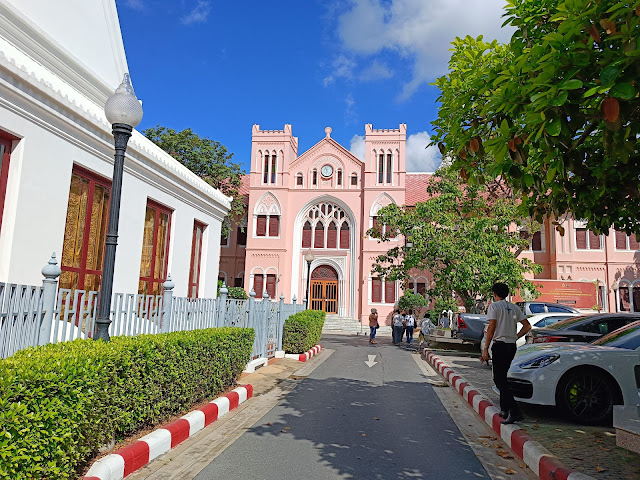Warning: A very long story, this!
On the third day of our stay in Bangkok, we were informed at breakfast that we’d be visiting the showroom of the second bronze casting foundry that we’d missed out on the day before. Apparently, the owner had been tracked down the previous evening and had agreed to meet us that afternoon. Since the place was supposed to be "quite nearby", we were told there was plenty of time, and we could spend the morning visiting two Buddhist temples first.
So off we went to the Wat Bowonniwetwiharn Ratchaworawiharn (วัดบวรนิเวศวิหาร ราชวรวิหาร), which happened to be the temple where Nandaka Vihara’s Chief Abbot, Bhante Dhammasubho, was ordained back in 1989. As he walked down the temple’s passageways steeped in Thai Buddhist history and tradition, I was sure memories came flooding back. He paused outside a stately building once occupied by the American monk who had shaved his head and helped him enter the sangha. But of course, that was more than 30 years ago, and the monk could no longer be there.
 In the heart of the temple stands the main pagoda, gleaming in its unmistakable golden hue. Beyond its striking appearance, it enshrines relics of the Buddha, making it a focal point of reverence for visitors. But there’s more. I’ve heard the pagoda also holds the ashes of Thai royalty. From a distance, it rises from an elevated base, and a closer look reveals Chinese-style pavilions and depictions of celestial and earth-bound beings from Chinese mythology on the lower terrace. On the upper terrace stands a statue of the Buddha known as Phra Pairi Pinat. Many visitors, I suspect, are so captivated by the pagoda that they miss the four small golden sculptures tucked into each corner—figures of an elephant, lion, eagle and horse, said to represent the centre of the universe, with Siam (Thailand) at its heart.
In the heart of the temple stands the main pagoda, gleaming in its unmistakable golden hue. Beyond its striking appearance, it enshrines relics of the Buddha, making it a focal point of reverence for visitors. But there’s more. I’ve heard the pagoda also holds the ashes of Thai royalty. From a distance, it rises from an elevated base, and a closer look reveals Chinese-style pavilions and depictions of celestial and earth-bound beings from Chinese mythology on the lower terrace. On the upper terrace stands a statue of the Buddha known as Phra Pairi Pinat. Many visitors, I suspect, are so captivated by the pagoda that they miss the four small golden sculptures tucked into each corner—figures of an elephant, lion, eagle and horse, said to represent the centre of the universe, with Siam (Thailand) at its heart.
 Elsewhere in the temple complex lies the Ubosot, or ordination hall, which houses two Buddha images: Phra Phuttha Suwannakhet and Phra Phuttha Chinasi. These statues are not only revered for their artistic and spiritual beauty but also for their connection to Thailand’s royal legacy. The ashes of both Rama VI and Bhumibol Adulyadej—both of whom had been ordained at this very temple—are kept within the Ubosot.
Elsewhere in the temple complex lies the Ubosot, or ordination hall, which houses two Buddha images: Phra Phuttha Suwannakhet and Phra Phuttha Chinasi. These statues are not only revered for their artistic and spiritual beauty but also for their connection to Thailand’s royal legacy. The ashes of both Rama VI and Bhumibol Adulyadej—both of whom had been ordained at this very temple—are kept within the Ubosot.There was a third building we attempted to enter—possibly the Phra Satsada temple—but it was undergoing heavy renovations. Bhante Dhammasubho and William ventured in, picking their way through the metal scaffolding, with me trailing behind. But we kept hitting dead ends, so we eventually turned back. My story continues after the pictures below.
 |
| This building resembles a European gothic church but it is actually a Buddhist museum and library |
Our next stop was the Wat Paknam Phasi Charoen (วัดปากน้ำภาษีเจริญ), a sprawling 32,000-square-metre temple complex. With limited time on our hands and the temple’s massive outdoor Buddha statue hidden under scaffolding for repairs, we focused our visit on the pagoda. But first, we had to walk through a long covered passageway that led us past a small pavilion honouring one of the temple’s former abbots who passed away in 1959. That’s something uniquely Thai. They have no hesitation about venerating monks after death. Lifelike statues are made in their image, often becoming objects of veneration. If there's a reason for this, I haven't understood it yet. Anyway, that kind of practice wouldn't be seen among Malaysian Buddhists. In this case, Luang Pu Sodh, a highly respected former abbot, was honoured with not one but two seated statues. One of them was covered in layers of gold leaf foil. A gold leaf-foiled elephant statue nearby added to the eclectic scene.
From the pavilion, we continued to the temple’s impressive Maharatchamongkhon Pagoda (มหารัชมงคล), an 80-metre-high structure completed in 2012 after eight years of construction. The pagoda houses five floors, accessible by both stairs and lift. At the top was an eight-metre glass stupa surrounded by a luminous domed ceiling adorned with neon-hued artwork. A floor below, we found relics, Buddha images and portraits of esteemed monks. My story continues after more pictures below.
Lunch followed at the Kathi Baan Thai Food and Desserts (กะทิบ้านอาหารไทยและขนม) restaurant, not too far from the Wat Paknam. The food was decent—nothing spectacular—but the restaurant’s surroundings were quite a treat. There was a walkway lined with a koi pond teeming with colourful Japanese carp. The place had been designed to simulate a shaded forest setting, complete with leafy paths, a flowing stream and a small artificial waterfall.
With lunch done, it was time for the main item on our Day Three itinerary—a meeting with the boss of the second foundry. Since we’d been told earlier that the showroom was “quite nearby,” we settled into our seats expecting a short hop across Bangkok. But no, it turned into another long 90-minute drive back to Ang Thong province. Some landmarks along the way looked familiar as we’d passed them before. My story continues after even more pictures below.
Eventually, we arrived at their Independence Square (ลานอิสรภาพ ๑๐๙), home to three gigantic statues, including one of Naresuan, one of Thailand’s most revered historical figures. He’s remembered for freeing Ayutthaya from Burmese rule and waging multiple campaigns against the Taungoo Empire. His massive statue here, standing 109 metres tall, shows him pouring water onto the ground, symbolising the declaration of independence from Burma. Naresuan’s legend looms large in Thai history and pop culture, with statues, memorial parks and countless retellings on television.
At the edge of this square stood the Asia Fine Art Foundry’s showroom. While we waited for the owner to arrive, we took the chance to wander about and admire the foundry’s creations: not only statues of the Buddha and famous Thai figures, but also Hindu deities like Ganesha and Vishnu.
When the owner finally arrived, he respectfully prostrated himself before Bhante Dhammasubho. Discussions followed—out of my earshot—but eventually, a deal was struck for the production of five bronze Buddha statues for the Nandaka Vihara.
With that done, we were finally on our way back to Bangkok. Another hour and a half on the road, but before heading back to the hotel, we were dropped off at Mixt Chatuchak Mall and later at Platinum Fashion Mall for a bit of shopping and quick dinner to round off a long and, I suppose, fulfilling day.
#WatBowonniwetwiharn #วัดบวรนิเวศวิหารราชวรวิหาร #WatPaknam #วัดปากน้ำภาษีเจริญ #IndependenceSquare #ลานอิสรภาพ๑๐๙ #Naresuan
 In the heart of the temple stands the main pagoda, gleaming in its unmistakable golden hue. Beyond its striking appearance, it enshrines relics of the Buddha, making it a focal point of reverence for visitors. But there’s more. I’ve heard the pagoda also holds the ashes of Thai royalty. From a distance, it rises from an elevated base, and a closer look reveals Chinese-style pavilions and depictions of celestial and earth-bound beings from Chinese mythology on the lower terrace. On the upper terrace stands a statue of the Buddha known as Phra Pairi Pinat. Many visitors, I suspect, are so captivated by the pagoda that they miss the four small golden sculptures tucked into each corner—figures of an elephant, lion, eagle and horse, said to represent the centre of the universe, with Siam (Thailand) at its heart.
In the heart of the temple stands the main pagoda, gleaming in its unmistakable golden hue. Beyond its striking appearance, it enshrines relics of the Buddha, making it a focal point of reverence for visitors. But there’s more. I’ve heard the pagoda also holds the ashes of Thai royalty. From a distance, it rises from an elevated base, and a closer look reveals Chinese-style pavilions and depictions of celestial and earth-bound beings from Chinese mythology on the lower terrace. On the upper terrace stands a statue of the Buddha known as Phra Pairi Pinat. Many visitors, I suspect, are so captivated by the pagoda that they miss the four small golden sculptures tucked into each corner—figures of an elephant, lion, eagle and horse, said to represent the centre of the universe, with Siam (Thailand) at its heart. Elsewhere in the temple complex lies the Ubosot, or ordination hall, which houses two Buddha images: Phra Phuttha Suwannakhet and Phra Phuttha Chinasi. These statues are not only revered for their artistic and spiritual beauty but also for their connection to Thailand’s royal legacy. The ashes of both Rama VI and Bhumibol Adulyadej—both of whom had been ordained at this very temple—are kept within the Ubosot.
Elsewhere in the temple complex lies the Ubosot, or ordination hall, which houses two Buddha images: Phra Phuttha Suwannakhet and Phra Phuttha Chinasi. These statues are not only revered for their artistic and spiritual beauty but also for their connection to Thailand’s royal legacy. The ashes of both Rama VI and Bhumibol Adulyadej—both of whom had been ordained at this very temple—are kept within the Ubosot.


















































